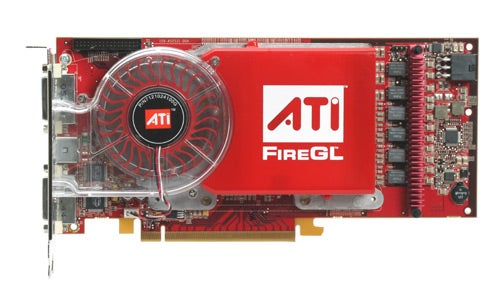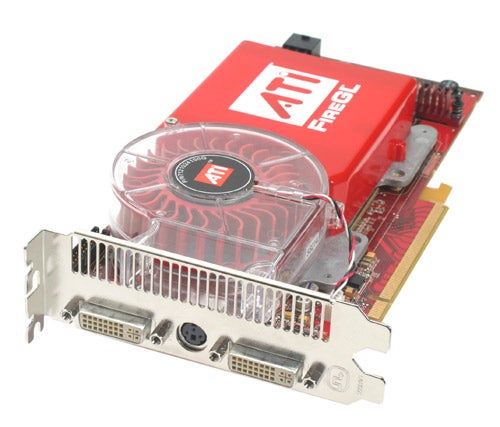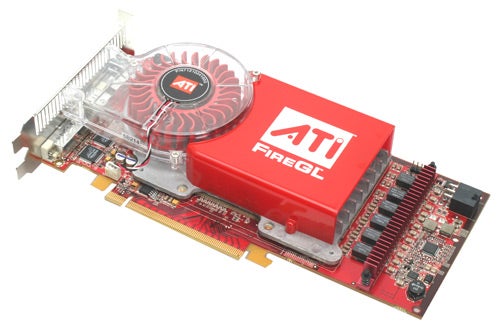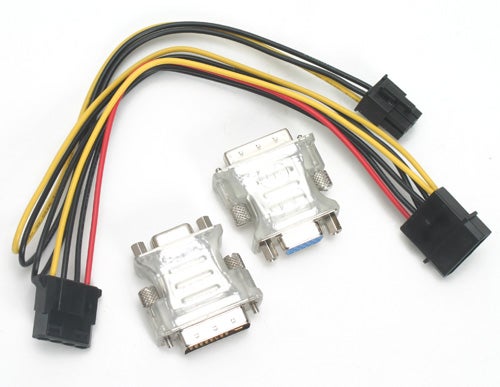ATi FireGL V7350 Review
ATi FireGL V7350
ATI ups the ante in the workstation graphics market by throwing a massive 1GB of memory at its latest card.

Verdict
Key Specifications
- Review Price: £1350.00
It has been a bittersweet few months in workstation graphics. On the one hand, long-time leader 3dlabs has finally thrown in the towel, as owner Creative ‘refocuses on the growing mobile graphics market’. But while it’s sad to see one of the founding fathers of professional 3D acceleration bite the dust, it also indicates something much more positive: that the products from the mainstream brands are now just as good, if not better.
One of the key brands in 3dlabs downfall has been ATi’s FireGL, the latest generation of which has just arrived. The V7300 and V7350 both use technology derived from the X1800 series of consumer cards, although customised for the professional workstation market. The FireGL V7350 is particularly notable for being the first mainstream accelerator to sport a whopping 1GB of on-board memory, while the V7300 offers a more mainstream 512MB.

The primary benefit of the 1GB of RAM on the FireGL V7350 is that it allows extremely large texture sets, which can be very important in 3D animation. However, both FireGL cards can support absolutely stupendous resolutions. If you thought Dell’s 3007WFP was massive, its 2,560 x 1,600 is still behind the V7350’s maximum capabilities. The FireGL card can support monitors with resolutions up to 3,840 x 2,400 via dual-link DVI, and it has two outputs. However, the ATi can only maintain this resolution at 48Hz, so 2,560 x 1,600 at 60Hz is a more realistic maximum, which nVidia’s Quadro FX 4500 can match. This may sound like overkill, but if you’re working on film-resolution 3D frames at 4,000 pixels across, the higher your native desktop resolution the better.
It’s worth bearing in mind, however, that now the volume consumer market drives the development of new GPUs, professional workstation cards from ATi and nVidia lag behind their gaming products by a few months. As a result, while the consumer is now basking in the glory of the X1900XTX using the latest R580 GPU, the FireGL V7300 and V7350 use a GPU derived from its R520 predecessor, which was so horribly delayed in the consumer space it nearly came out after its successor. So the V7350 has just 16 pixel pipelines and eight vertex pipelines. In contrast, nVidia’s G70-based Quadro FX 4500 has 24 and eight pipelines respectively. Still, the ATi card runs with higher clocks, using a 600MHz core and 1,300MHz memory, where nVidia’s Quadro FX 4500 operates at 470MHz and 1,050MHz respectively, offering some compensation.

But although the rapid development of gaming GPUs has swept the professional market along in its wake, the two worlds do still have different needs. Whereas gaming now focuses on shading to create the eye candy in the latest titles, professionals rely on raw geometry and texturing power. So while ATi’s latest R580, with its 48 shader units, is an absolute champ at accelerating Direct3D games, it’s questionable whether it would be so effective in the workstation market. This is presumably why ATi hasn’t skipped a generation with the FireGL and gone straight to the R580 core. The R520 might be more appropriate for this market anyway.
ATi is also making a song and dance about the Avivo technology in the new FireGLs. This groups together a bunch of image enhancement technologies. The 10-bit rendering pipeline means supporting monitors can display a higher dynamic range of over a billion colours, which will be particularly useful in medical markets. Allied with this, 64-bit per pixel display output allows the FireGL V7350 to differentiate between over one trillion colours during processing.

The V7350 card is genlock ready, so you will be able lock it into your production house timecode generation for frame-perfect synchronisation, although the necessary daughter card won’t be available until the second half of 2006. Avivo is also the umbrella under which the X1000-series much-vaunted acceleration of H.264 video playback is subsumed. According to ATi, the FireGL offers hardware support of H.264 up to 1080i. To round off Avivo, HD Component and quad-buffered stereoscopic 3D output are provided.
We put the 1GB FireGL V7350 through its paces in a 3.6GHz Pentium 4 560 workstation. The results were encouraging, considering that we were using early pre-WQHL certification drivers. The V7350 recorded scores which show the new cards will be giving nVidia’s Quadros a run for their money in a number of areas. We ran the industry-standard SPECviewperf 8.1 and compared the results to nVidia’s official scores for its Quadro FX range here, which were also run on a 3.6GHz Pentium 4 workstation.

The V7350 is already outclassing the Quadro FX 3450 and 4400 in the Unigraphics (UGS-04), SolidWorks (SW-01) and 3dsmax (3dsmax-03) tests, and is nearly on par in Pro/Engineer (Proe-03). It even managed to reel nVidia’s flagship Quadro FX 4500 in with 3dsmax, although the 4500 was noticeably ahead in other scores. We fully expect the V7350 to pull closer to the 4500 as its drivers mature, although it has some way to go in Pro/Engineer. Our workstation was also based on Intel’s 915 PCI Express chipset, rather than the higher-performing 925, 955 or 975, which would have had a small effect on our results.
We also ran Maxon Cinebench 9.5 and 3DMark06. The Cinebench results were very similar to what nVidia’s Quadro FX 4500 achieves on the same platform. The 3DMark06 score isn’t as high as the latest gaming cards, but it isn’t far off either, which is good news for games developers hoping to be able to perform Direct3D testing on their animation design workstation. Here, the card’s shader power makes itself known.
”’Verdict”’
Workstation accelerators are very application specific, and the best choice of hardware can depend greatly on which specific content creation application you want to use. But initial testing with the FireGL V7350 shows promise for both 3D animation and CAD users. We don’t yet have confirmed UK pricing for the V7300 and V7350, but the suggested retail prices are $1,599 and $1,999 respectively (the Sterling price at the top of this review is an estimate based on current exchange rates). Considering that nVidia’s Quadro FX 4500 will set you back £1,000 – £1,500, the 1GB FireGL card won’t be much more expensive than nVidia’s 512MB competitor, and the 512MB V7300 could be cheaper.
However, it’s not clear that the FireGL V7350 will ever absolutely trounce the Quadro FX 4500 on performance. We suspect it will come close with many apps, and it’s already faster if you use 3dsmax. But it’s unlikely to pull ahead in every case. So unless you use texture sets to take advantage of the 1GB memory, it really will be horses for courses, and the choice comes down to which specific software you will mostly be using.
—-
”’SPECviewperf 8.1”’
(table:spec)
—-
”’Maxon Cinebench”’
(table:cinebench)
—
Trusted Score
Score in detail
-
Value 7
-
Features 9
-
Performance 9


